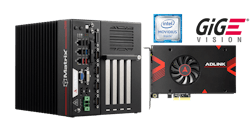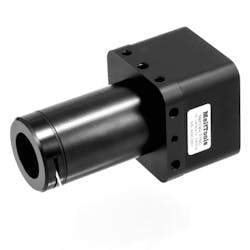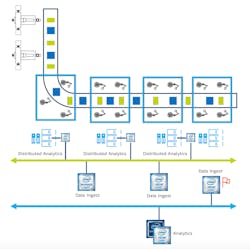John Deere and Audi Apply Intel’s AI Technology
While many early applications of artificial intelligence (AI) in manufacturing focused on data analytics and identifying product and component defects with machine vision, use of the technology is already expanding beyond such applications in the real world. Two good examples of this can be seen at John Deere and Audi, where Intel’s AI technology is being used to improve welding processes.
She added that, as with Deere, Intel met with Audi at a conference years ago and “the first project we worked on was spot welding quality detection in Audi’s Neckarsulm plant.” Boles added that this initial project with Audi has since expanded into other areas of collaboration around edge analytics and machine learning.
Deere’s weld porosity application
Identifying defects in welds is a common quality control process in manufacturing. To make these inspections more accurate,John Deere is applying computer vision, coupled with Intel’s AI technology, to automatically spot common defects in the automated welding process used in its manufacturing facilities.Gas metal arc welding (GMAW) is used at Deere’s 52 factories around the world to weld mild- to high-strength steel to create machines and products. Across these factories, hundreds of robotic arms consume millions of pounds of weld wire annually.
The specific welding issue Deere is looking to address with Intel’s AI technology is porosity—cavities in the weld metal caused by trapped gas bubbles as the weld cools. These cavities weaken the weld strength.
It’s critical to find porosity defects early in the manufacturing process because, if these flaws are found later, re-work or even scrapping of full assemblies is often required.
Combining an industrial grade ADLink Machine Vision Platform and a MeltTools welding camera, the edge system at Deere is powered by Intel Core i7 processors and uses Intel Movidius VPUs (vision processing units) and the Intel Distribution of OpenVINO toolkit.
“Deere is leveraging AI and machine vision to solve a common challenge with robotic welding,” said Boles. “By leveraging Intel technology and smart infrastructure in their factories, Deere is positioning themselves to capitalize not only on this welding solution, but potentially others that emerge as part of their broader Industry 4.0 transformation.”
Audi’s weld quality application
At Audi, automated welding applications range from spot welding to riveting. The widespread automation in Audi factories is part of the company’s goal of creating Industrie 4.0-level smart factories.A key aspect of this goal involves Audi’s recognition that creating customized hardware and software to handle individual use cases is not preferrable. Instead, the company focuses on developing scalable and flexible platforms that allow them to more broadly apply advanced digital capabilities such as data analytics, machine learning, and edge computing.
Nine hundred of the 2,500 autonomous robots on its production line at this facility carry welding guns to do spot welds that hold pieces of metal together. To ensure the quality of its welds, Audi performs manual quality control inspections. Because it’s impossible to manually inspect 1,000 cars every day, Audi uses the industry’s standard sampling method.
To do this, “Audi pulls one car off the line each day and 18 engineers with clipboards use ultrasound probes to test the welding spots and record the quality of every spot,” says Rita Wouhaybi, principal engineer for the Internet of Things Group in the Industrial Solutions Division at Intel and lead architect for Intel’s Industrial Edge Insights software.
To cost effectively test the welds on the other 999 vehicles produced each day, Audi worked with Intel to create algorithms using Intel’s Industrial Edge Insights software and the Nebbiolo edge platform for streaming analytics. The machine-learning algorithm developed by Intel’s data scientists for this application was trained for accuracy by comparing the predictions it generated to actual inspection data provided by Audi.
The machine learning model uses data generated by the welding controllers, rather than the robot controllers, so that electric voltage and current curves during the welding operation can be tracked. Other weld data used includes configuration of the welds, the types of metal, and the health of the electrodes.
A dashboard lets Audi employees visualize the data, and the system alerts technicians whenever it detects a faulty weld or a potential change in the configuration that could minimize or eliminate the faults altogether.
According to Intel, the result is a scalable, flexible platform that Audi can use to improve quality control for spot welding and as the foundation for other use cases involving robots and controllers such as riveting, gluing, and painting.
“Intel was the project leader,” said Mathias Mayer of the Data Driven Production Tech Hub at the Audi Neckarsulm site. “They have production experience as well as knowing how to set up a system that does statistical process control. This is completely new to us. Intel taught us how to understand the data, how to use the algorithms to analyze data at the edge, and how we can work with data in the future to improve our operations on the factory floor.”
Henning Löser, senior manager of the Audi Production Lab, agrees: “This solution is like a blueprint for future solutions. We have a lot of technologies in the factory, and this solution is a model we can use to create quality-inspection solutions for those other technologies so that we don’t have to rely on manual inspections.”
Moving from manual inspections to an automated, data-driven process has allowed Audi to increase the scope and accuracy of its quality-control processes, said Löser. Other benefits include a 30%-50% reduction in labor costs at the Neckarsulm factory.
About the Author
David Greenfield, editor in chief
Editor in Chief

Leaders relevant to this article:




